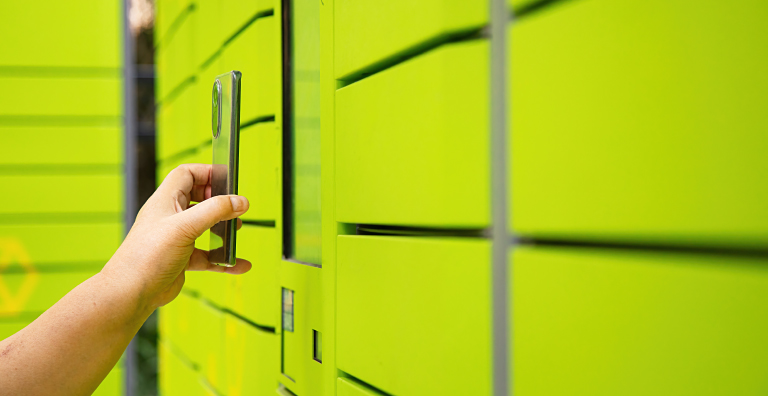Lockers Get a Smart Makeover
Many of us have that stressful, recurring dream where we forget our locker combination and are running late to class or our next meeting.
If that’s you, there’s change underway and good things are in store. Lockers are getting more intelligent, and that’s leading to newfound levels of flexibility, security and affordability across a range of spaces where we work, play and pass-through. Post-COVID, easy digital accessibility to physical “stuff” is an everyday expectation — not a lavish amenity or occasional convenience.
A Storage Renaissance
Standard lockers found across schools, gyms, theme parks and transportation venues have always been restrictive and inconvenient to manage. Nowadays, enterprises also have the need to provide their employees with a cost-effective but seamless physical storage experience. A core challenge involves manual keys, padlocks or combination locks and the clumsy process of replacing those physical keys and locks over time — each time — one gets lost. With traditional methods, managing dynamic group access is almost impossible. In addition, these static units are expensive to maintain between replacing parts, ongoing repairs and the security risks that come from mechanical locks and common keys that can be cut, picked or copied.
As people return to public places, we’re finding more uses for access to smart lockers thanks to evolving technologies and the significant shift in how we work. In corporate environments, a return to the workplace looks quite different, whether that’s full-time, part-time or hybrid. In addition, niche markets like smart offices, where smart lockers are popular, are projected to grow by 11.1% by 2030.
Studies also show that 74% of employers offer hybrid work arrangements to accommodate an agile, connected workplace where staff members rotate schedules. Many companies are rethinking their physical spaces entirely.
For example, “hot desking” is a big trend. This involves allocating shared workspaces as needed instead of providing each employee with their own desk or office. However, this approach leaves staff without a dedicated area for their possessions. Smart lockers are quickly becoming the critical, cost-effective answer to address today’s nimble workstyle.
Smart Spaces Hold Big Benefits
Today’s conveniences around smart storage not only benefit users who enjoy flexible and touchless operation using a variety of credentials (access cards, mobile phones, smart watches or tokens) — but also the businesses managing these blocks of lockers. Some of the incredible upsides include:
- Easy Administration — Change configuration, manage in real-time, remote monitoring/diagnostics/repair, and synchronize schedules and tasks, all from a central location
- Security — Controlled, digital access delivered by best-in-class online software system providers and lockers equipped with state-of the-art smart locks
- Affordability — Drastically reduce long-term total cost of ownership (labor and product)
- Streamlined Operations / Improved Visibility and Data Reporting — Assign lockers, record usage data (who has access to what and which units are underutilized), openings and closings for sensitive items (controlled substances), etc.
- Customization — Locker software can be tailored to specific use cases and organizational requirements
- Integration with Existing Software — Systems from leading vendors can seamlessly integrate with IT/access control/remote management systems for real-time insights including open doors, product drop-offs and pick-ups, etc.
- Sustainability — Low battery-power consumption optimizes operation and decreases total-cost-of-ownership
Teaching Old Lockers New Tricks
Beyond supporting an agile workplace with dynamic and smart locker access management, solutions like the HID OMNIKEY® Reader Modules and OMNIKEY® Secure Element technology give old-fashioned lockers across various venues a much-needed, modern makeover. Schools and universities easily and efficiently manage everyday encounters and annual turnover between incoming students and graduating classes. Hospitals and healthcare environments maintain compliance around storing controlled substances and medication dispensing. Enterprises can easily introduce new work concepts by providing their employees seamless and secure access to lockers for storing belongings safely. Retailers rely on refrigerated lockers for a variety of grocery- and pharmacy-related purposes. Hotels, fitness centers, entertainment arenas and more gain simple, secure and convenient methods for managing smart lockers for patrons.
A single trusted identity — such as an RFID access card, mobile app or wearable — is the key that unlocks standard spaces and transforms them into modern multi-purpose storage systems for a connected workplace.
Let’s get you dialed into this winning combination and discuss how you can leverage your existing HID-based access credentials — or easily incorporate/retrofit smart locker intelligence — to elevate your digital space. Read our eBook, Smart Lockers: A Storage Renaissance, to get started >>
Marc Butler is a Product Manager with global responsibility for the RFID Desktop and Embedded portfolio within the Extended Access Technologies Business Area. Marc brings extensive commercial and technical expertise in both domestic and export markets, a background in technical support and account management, along with 30 years’ experience in the security industry. An effective communicator at all levels within the organization, his proven abilities in producing market requirement specifications provide business case justification for new product development.
